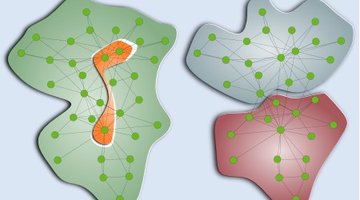Statistical inference for complex network discovery and feature extraction
Dates: from Jan. 1, 2010 to June 30, 2014
Funder: MINECO (Spain)
Project id: FIS2010-18639
Total Funding: 45,000€
Visit the project web page
In complex systems, individual components interact with each other giving rise to complex networks of interactions that are neither totally regular nor totally random. Although during the last decade significant progress has been made in the study of complex networks, we are still far from the ultimate goals of: (i) characterizing real-world complex networks; (ii) understanding the precise mechanisms responsible for the observed topology; and (iii) evaluating the impact of the structure of the network on the dynamics of the system.
The two main impairments to achieve these goals are: (i) most network data are very unreliable, that is, for most systems there is uncertainty as to what is the real structure of the network; and (ii) we lack the tools to extract the relevant information contained in the structure of networks, and to evaluate the impact of network structure on a system’s dynamics.
The general aims of the project are to advance in the solution of the two challenges described above by developing theoretical tools for network reliability assessment and feature extraction, and to apply these tools to biological and socio-economic systems of interest. We are going to approach these problems using statistical physics and group-based models of complex networks. More specifically, we propose to develop a statistical mechanics framework for assessing network reliability and for network discovery (that is, to infer the whole network from a partial observation of it). We will also develop a framework for network feature extraction based on the identification of the most relevant network partitions and of those connections that deviate from the predominant patterns. Finally, we will apply the theoretical tools developed within the project to: (i) biological systems and (ii) socio-economic systems.
Publications
- Long-term evolution of email networks: statistical regularities, predictability and stability of social behaviors - PLOS ONE 11(1) , e0146113 (2016).
- A comprehensive study on different modelling approaches to predict platelet deposition rates in a perfusion chamber - Sci. Rep. 5 , 13606 (2015).
- The acute impact of polyphenols from Hibiscus sabdariffa in metabolic homeostasis: an approach combining metabolomics and gene-expression analyses - Food Funct. 6 , 2957 -2966 (2015).
- Control of cell–cell forces and collective cell dynamics by the intercellular adhesome - Nat. Cell Biol. 17 , 409 -420 (2015).
- Identifying strategies for mitigating the global warming impact of the EU-25 economy using a multi-objective input–output approach - Energ. Policy 77 , 21 -30 (2015).
- Impact of heterogeneity and socioeconomic factors on individual behavior in decentralized sharing ecosystems - Proc. Natl. Acad. Sci. U. S. A. 111 (43) , 15322 -15327 (2014).
- A Network Inference Method for Large-Scale Unsupervised Identification of Novel Drug-Drug Interactions - PLOS Comput. Biol. 9 (12) , e1003374 (2013).
- Degree of intervality of food webs: From body-size data to models - J. Theor. Biol. 334 , 35 -44 (2013).
- Predicting future conflict between team-members with parameter-free models of social networks - Sci. Rep. 3 , art. no. 1999 (2013).
- The impact of individual biases on consensus formation - PLOS ONE 8 (5) , e58989 (2013).
- Use of a global metabolic network to curate organismal metabolic networks - Sci. Rep. 3 , art. no. 1695 (2013).
- Phenomenological model for predicting the catabolic potential of an arbitrary nutrient - PLOS Comput. Bio. , 8(11): e1002762 (2012).
- Predicting Human Preferences Using the Block Structure of Complex Social Networks - PLOS ONE 7 (9) , e44620 (2012).
- Evolutionary Conservation of Species’ Roles in Food Webs - Science 335 , 1489 -1492 (2012).
- Justice Blocks and Predictability of US Supreme Court Votes - PLOS ONE 6 (11) , e27188 (2011).
- Modular coherence of protein dynamics in yeast cell polarity system - Proc. Natl. Acad. Sci. U. S. A. 108 , 7647 -7652 (2011).


